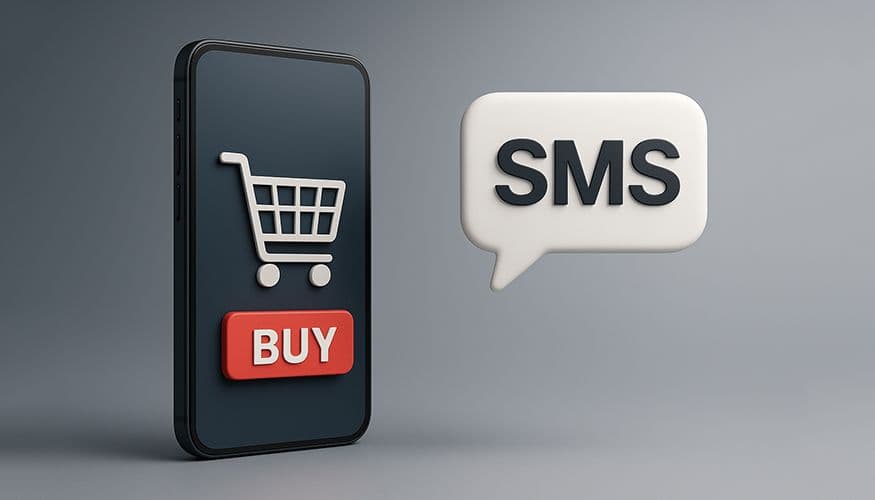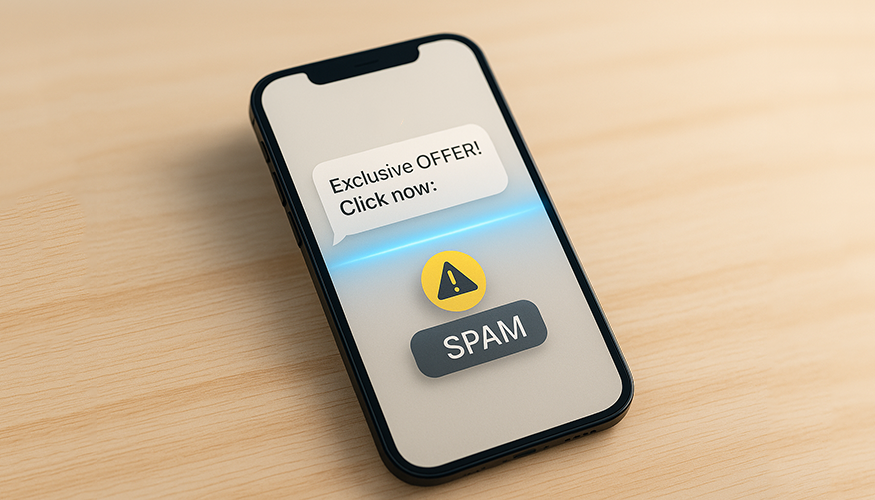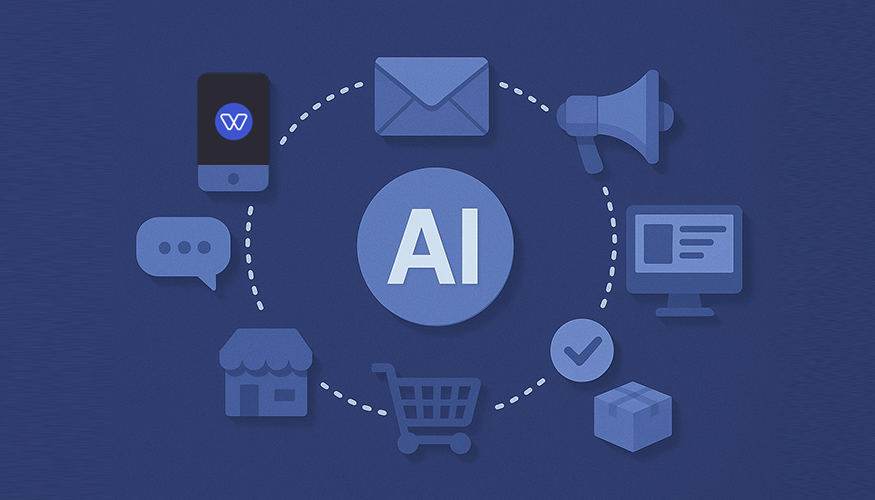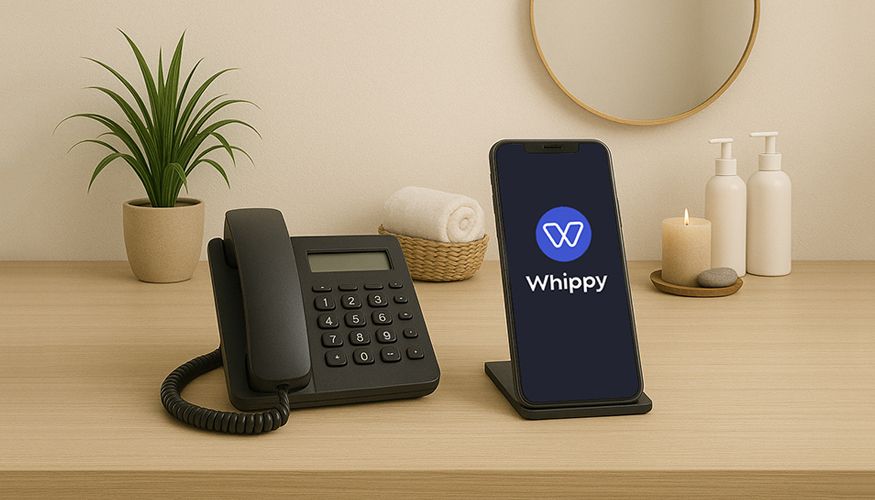Table of Contents
- Looking for an Ecommerce SMS platform with AI-powered conversational SMS and intuitive automation? Try the Whippy platform↗
- What is SMS Marketing?
- Why Ecommerce SMS Works
- SMS Marketing Statistics (Ecommerce) in 2025
- Compliance First: TCPA, 10DLC & Short Codes (and spam laws)
- 10DLC vs Short Code: Which Is Right for Ecommerce SMS ?
- Your Ecommerce SMS Strategy Guide: How to Do SMS Marketing for Ecommerce
- Automated Flows That Print Revenue: Ecommerce Text Marketing Examples That Convert
- Segmentation that Boosts Conversion / ROI
- AI-Powered Ecommerce SMS Marketing (and two-way SMS)
- MMS vs SMS (and when to use RCS)
- SMS Marketing vs Email (for ecommerce)
- SMS Marketing Strategies & A/B Tests you Can Run this Week
- Building your Subscriber List (fast, but the right way)
- Ecommerce SMS Templates (ready to copy)
- Ecommerce SMS Automation Best Practices
- Measurement: From Vanity to Value
- Shopify SMS Marketing – Potential Use Cases
- FAQ
- The Bottom Line
Try Whippy for Your Team
Experience how fast, automated communication drives growth.

Ecommerce SMS marketing is the practice of sending consent-based text messages—both promotional SMS messages (such as limited-time discount codes) and automated text notifications (like order updates & shipping notifications SMS)—to engage shoppers, improve customer experience, and drive measurable conversion / ROI.
This comprehensive SMS marketing for ecommerce (guide) walks you through best practices—from compliance and automation to segmentation and AI-powered personalization—to help your online store maximize conversions.
For ecommerce businesses, the winning formula is simple:
1. Ensure compliance (opt-in & opt-out) under TCPA and 10DLC↗ & short codes.
2. Grow your subscriber list using on-site popups, checkout consent, and strategic SMS keywords.
3. Launch automated SMS flows such as abandoned cart SMS, order & shipping SMS, loyalty, and win-back sequences↗—core examples of text message marketing for ecommerce (how-to) that show immediate impact.
4. Apply advanced SMS ecommerce marketing strategies like SMS segmentation, personalization, and SMS A/B testing (for ecommerce).
5. Track results with Advanced KPI tracking (conversion per SMS sent, revenue per subscriber, and retention impact).
When executed well, SMS becomes more than a support channel—it evolves into a primary sales driver that outperforms many traditional email campaigns.
Looking for an Ecommerce SMS platform with AI-powered conversational SMS and intuitive automation? Try the Whippy platform↗
What is SMS Marketing?
SMS marketing definition: A permission-based marketing channel where ecommerce businesses send ecommerce text message marketing campaigns and order or shipping updates to customers who have opted in using their email address, phone number, or a keyword.
In modern ecommerce, SMS marketing for ecommerce stores isn’t just about sending alerts—it’s about building two-way relationships, driving engagement, and increasing repeat purchases through timely, personalized communication.
This practice goes beyond simple notifications. Today’s SMS marketing strategy includes:
Two-way SMS for interactive conversations.
Conversational SMS for answering questions about products or services instantly.
Order updates & shipping notifications SMS (transactional SMS) to provide peace of mind.
Promotional SMS messages with targeted discount codes, special drops, and loyalty offers.
Done right, SMS is as flexible and measurable as any email campaign, but with far higher response rates.
Why Ecommerce SMS Works
SMS thrives in ecommerce because it blends reach, immediacy, and personalization in ways other channels can’t.
- High-open rates: Nearly every text gets read, often within minutes, unlike many email campaigns that land in promotions tabs.
- Response rates: Whether sending a flash sale or follow-up after an abandoned cart, SMS has response rates 5–10x higher than email.
- Customer experience: Real-time shipping notifications and back-in-stock alerts keep customers engaged and loyal.
- Promotions and discount codes: Deliver time-sensitive offers that encourage immediate purchases.
- Integration with email: SMS doesn’t replace collecting an email address or running email campaigns—instead, it enhances the overall SMS marketing strategy by handling urgency while email builds the long-term narrative.
- Visual impact: MMS marketing (vs SMS) and RCS messaging (Rich Communication Services) for ecommerce let you add images, carousels, or product cards, which are especially persuasive for visual-first products or services.
For ecommerce businesses, SMS is no longer “nice to have”—it’s the channel that keeps subscriber lists engaged and buying.
SMS Marketing Statistics (Ecommerce) in 2025
To understand why SMS is so powerful, look at the numbers driving SMS statistics this year:
- 98% open rates → SMS is nearly always seen, compared to ~20% for email.
- 45% average response rate → vs 6% for email, showing SMS outperforms traditional email campaigns in engagement.
- 23% cart recovery rate when abandoned cart SMS is included in automated flows, proving the direct impact on revenue.
- 8–12x ROI is typical for brands that run full automated SMS flows with segmentation, surpassing most paid ad channels.
- (1.3K/28%) → Roughly 1,300 monthly searches for “ecommerce SMS marketing,” with 28% of clicks going to organic results (high-intent audience).
- (10/n/a) → 10-digit long codes (10DLC) are now required for compliance with U.S. carriers; ecommerce brands that skip registration risk blocked messages.
These stats make it clear: SMS isn’t just supplemental—it’s a core driver of conversion / ROI and an essential piece of any modern SMS marketing strategy.
Compliance First: TCPA, 10DLC & Short Codes (and spam laws)
Before you send a single message from any SMS marketing platform, you need to understand compliance. SMS compliance (TCPA / 10DLC / short codes) and compliance (opt-in/opt-out – spam laws) are not just legal requirements—they’re also the foundation of trust with your potential customers.
Opt-In & Opt-Out
Every campaign should start with explicit, unambiguous consent. Capturing consent through popups, checkout boxes, or forms is the gold standard.
A double opt-in (where customers confirm twice) strengthens compliance and ensures you’re building a high-quality subscriber list. On the flip side, you must always provide an easy opt-out path.
Supporting a simple “Text STOP to opt out” is required, but you can go further by offering preference centers where a customer interacts with their options (e.g., choosing to receive only transactional texts or limiting promotional SMS messages to weekends).
10DLC & Short Codes
- 10DLC (10-digit long code): This is ideal for branded numbers and especially for two-way SMS, where customers expect to reply and get real-time responses. Ecommerce teams often use 10DLC for conversational flows like customer service, FAQs about products and services, and loyalty inquiries.
- Short codes: These are better suited for bulk campaigns such as flash sales, product launches, or national promotions. Their high throughput ensures timely delivery to thousands of recipients at once.
Quiet Hours & Frequency
Even if your SMS marketing strategy is airtight, frequency abuse can cost you subscribers. Comply with carrier rules about “quiet hours” and align messages with local time zones. This respects both the law and the customer experience.
Privacy & Record-Keeping
Keep data collection minimal and transparent. Store proof of consent, campaign terms, and timestamps so you can demonstrate compliance if ever challenged. Using a cost effective centralized SMS marketing platform like Whippy makes record-keeping and audits simpler.
SMS Keywords & Segmentation
SMS keywords like “JOIN,” “VIP,” or “DEALS” let potential customers self-segment. A shopper who texts “VIP” can automatically receive exclusive discount codes and early product launches, while someone who texts “INFO” may be added to a list that focuses on service or delivery alerts such as shipping updates.
Choosing the Best Ecommerce SMS Platform for Automation and Compliance
The best ecommerce SMS platforms combine automation, compliance, and analytics in one place. Whether you’re using Whippy or another provider, make sure your tool supports 10DLC registration, automated SMS flows, and real-time reporting for ecommerce teams.
In short: compliance is not just about avoiding penalties—it’s about building credibility and fostering long-term trust that turns potential customers into loyal advocates of your products and services.
10DLC vs Short Code: Which Is Right for Ecommerce SMS ?
Feature | 10DLC (10-Digit Long Code) | Short Code |
|---|---|---|
Digit length / format | 10 digits, looks like a standard local number | 5–6 digits, short and easy to recognize |
Typical use case | Two-way conversations, customer service, localized campaigns | High-volume one-way marketing campaigns |
Setup & approval time | Faster to register and deploy; requires A2P 10DLC registration | Longer approval time; vetted by carriers |
Cost & scale suitability | Lower cost; ideal for small to mid-sized brands | Higher cost; built for enterprise-level volume |
Throughput / delivery speed | Moderate throughput | Very high throughput |
Best for ecommerce brands when… | You want personalized, conversational engagement | You need to deliver bulk promotions quickly |
🛈 Disclaimer: Information in this table has been summarized from multiple reputable industry and carrier documentation sources to provide an accurate general comparison. Details may vary depending on region, carrier, or SMS platform provider.
Your Ecommerce SMS Strategy Guide:
How to Do SMS Marketing for Ecommerce
Building a winning SMS marketing strategy requires thinking about the full lifecycle: from capturing subscribers to sending the right mix of order confirmation texts and promotional SMS messages, and finally analyzing what works best for your ecommerce businesses.
Before diving into strategy, here’s how Whippy makes it easy to get started. From a single dashboard, you can create new campaigns, set triggers, and automate messages with just a few clicks:

1. Audience & Goals
Set clear objectives: Is your primary aim conversion / ROI, list growth, or customer retention? For many ecommerce businesses, the priority is driving revenue per send while simultaneously elevating customer experience.
2. List Growth
Effective list growth goes beyond asking for a phone number. Onsite popups can request both email address and phone number, creating an omnichannel record of each customer. When a customer interacts with both SMS and email campaigns, your messaging becomes more powerful. QR codes on packaging, loyalty sign-ups, and social promotions also fuel subscriber growth.
3. Foundational Automations
Turn on automated SMS flows as the backbone of your program:
- Abandoned cart / cart recovery SMS: Recover lost sales with gentle reminders and even discount codes.
- Order & shipping SMS (transactional): Confirm purchases, provide shipping notifications, and reassure potential customers that their orders are on track.
- Browse-abandon, back-in-stock, low-stock: Notify when products and services become available again.
- Loyalty & VIP: Reward frequent buyers with exclusive product launches or early access.
- Retention: Send replenishment reminders for consumables or win-back offers at 30–60 days.
4. Segmentation & Personalization
Not all customers are the same. Use behavioral segmentation and hyper-personalization to create personalized SMS experiences:
- Segment by customer interacts data (purchases, browsing, lifetime value).
- Tailor messages: “Because you bought {{product}}, you may love this too.”
- Deliver different flows for new subscribers vs repeat buyers.
5. Content Mix
A balanced SMS marketing strategy uses both transactional SMS messages and promotional ones:
- Transactional SMS messages: Order confirmations, shipping notifications, refunds, and delivery updates. These are the backbone of trust.
- Promotional SMS messages: Product launches, seasonal discount codes, bundles, and flash sales.
- Educational content: Tips, FAQs, or usage guides for your products and services, delivered in short, useful bursts.
6. Testing
Use SMS A/B testing (for ecommerce) to refine messaging. Test not just copy, but timing, offers, and even two-way SMS engagement vs one-way blasts. This ensures campaigns remain cost effective by focusing resources on high-performing strategies.
7. Measurement
Go beyond open rates. Track:
- Conversion per SMS sent
- Revenue per subscriber
- SMS statistics like unsubscribe rates and complaint rates
- Time-to-first-response for two-way SMS interactions
- Retention impact vs non-subscribers
When tracked through a modern SMS marketing platform, these metrics reveal not just vanity outcomes but real business value.
Automated Flows That Print Revenue: Ecommerce Text Marketing Examples That Convert
Below are proven SMS campaign examples that show how ecommerce brands use automation to recover carts, re-engage customers, and boost ROI through targeted SMS flows.
One of the greatest SMS marketing benefits for ecommerce businesses is the ability to automate communications.
Automated flows save time, keep your brand top-of-mind, and convert potential customers into loyal, engaged buyers — all without constant manual work.
Inside Whippy, ecommerce teams can easily create automated SMS sequences and preview how each message looks on a customer’s phone before launch.
This live preview feature helps ensure tone, timing, and design are optimized for engagement and conversion:

For a step-by-step breakdown of setting up reply automations and nurturing conversations, see Whippy’s full SMS Auto Reply Guide↗
These flows are scalable, predictable, and incredibly cost-effective, which is why they’re at the heart of every successful SMS marketing strategy for ecommerce.
1) Abandoned Cart SMS / Cart Recovery SMS
- Trigger: A cart is created but no purchase is made after 30–60 minutes.
- Why it works: The customer has already shown intent by adding products and services to the cart. A quick, relevant reminder provides a sense of urgency that nudges them toward purchase.
- SMS marketing templates:
- “Still thinking it over? Your cart’s saved—complete your order here: {{short_link}}”
- “{{first_name}}, we’ve held your {{item_name}}. Checkout in 2 taps: {{short_link}}”
Pro tip: Cap reminders at two and, if appropriate, offer a special offer like a free shipping code in the second message. Always pair with MMS images of the carted product for extra persuasion. This flow is among the most proven in text message marketing for ecommerce (how-to) because it directly addresses lost revenue.
2) Order & Shipping SMS (transactional)
Shipping confirmations and updates are essential for trust-building. They keep mobile phones buzzing with the updates customers want most.
- Triggers: order confirmation, shipped, out for delivery, or delivered.
- SMS templates:
- “Order #{{id}} confirmed ✅ Track anytime: {{tracking_link}}”
- “Out for delivery today 📦 Be ready! {{tracking_link}}”
This flow doesn’t just improve customer experience—it also reduces support volume (“Where is my order?” tickets). Compliance-wise, remember TCPA requires that transactional updates only go to subscribers who opted in.
3) Post-Purchase + Loyalty
After purchase, keep the subscriber list warm:
- Ask for reviews or user-generated content.
- Send loyalty program invitations with early access to product launches.
- Offer special offers like “10% off your next purchase” to maintain momentum.
By segmenting based on customers’ order history, you can deliver targeted SMS marketing templates that increase retention.
4) Browse Abandon / Price Drop / Back-in-Stock
Browsing without buying is a clear sign of interest. Automated messages here convert curiosity into sales.
- SMS template: “It’s back: {{item_name}}. We saved your size → {{short_link}}”
- Layer in MMS with product images to improve clicks.
- Combine with email lists for a multi-channel push—send an email reminder followed by an SMS for engaged customers.
5) VIP / Early Access
Your most loyal subscribers deserve exclusivity.
- SMS template: “VIP only: 2-hour early access to our drop. Reply SIZE for quick-buy.”
- Works best when combined with subscriber growth (pop-ups / checkout opt-in) that tags VIPs during SMS list building.
- This flow boosts retention by making customers feel recognized and valued.
Segmentation that Boosts Conversion / ROI
Segmentation is where SMS transforms from bulk alerts to truly personalized text message marketing for ecommerce (how-to).
- Lifecycle segmentation: Group by new subscribers, first-time buyers, active repeat customers, or lapsed users.
- Behavioral segmentation: Create segments based on customers’ recent browsing, cart value, or responsiveness to special offers.
- Location & timing: Adjust send times to align with when each customer interacts most. For example, a segment of mobile-first Gen Z shoppers may respond best to late-night promotions.
When you send personalized SMS that reflect someone’s journey, you increase trust, revenue, and loyalty—all while keeping your program cost effective.
AI-Powered Ecommerce SMS Marketing (and two-way SMS)
With modern tools, AI-powered ecommerce SMS marketing — the best approach for SMS automation for ecommerce brands — takes automation further:
- Two-way SMS: AI assistants can hold natural conversations, triaging questions about products and services, answering FAQs, or escalating to support.
- Send-time optimization: The system learns when each engaged customer is most likely to buy.
- Offer optimization: AI tests whether a special offer like free shipping outperforms a discount, adjusting flows dynamically.
Pairing these capabilities with Whippy’s AI-Powered Auto Attendant↗ ensures human-like engagement at scale—helping ecommerce teams automate messages while still sounding conversational and brand-consistent.
This is the future of sms marketing benefits: campaigns that adapt themselves in real time, always aiming for maximum conversion / ROI.
Expert Insight: Brands using AI-powered SMS automation see 2x higher repeat purchase rates and up to 30% faster response times compared to manual campaigns. The key is consistent personalization — AI tools like Whippy learn when to send, what to say, and how to keep customers engaged without overwhelming them.
MMS vs SMS (and when to use RCS)
- MMS marketing (vs SMS): Use images, GIFs, or videos to highlight product launches or high-value items.
- SMS: Quick, lean, and best for urgent alerts or critical order updates via SMS.
- RCS: Where supported, it merges both worlds, allowing interactive cards and verified senders that reassure potential customers.
By balancing these formats, ecommerce businesses can maximize SMS marketing benefits while keeping their subscriber list engaged.
SMS Marketing vs Email (for ecommerce)
The truth isn’t SMS vs email—it’s SMS and email.
- Email campaigns are ideal for storytelling, long-form content, and promotions that can wait.
- SMS excels in sense of urgency situations like limited-time special offers or abandoned cart reminders.
- Using both ensures that if one channel is ignored (e.g., cluttered inboxes), the other—on mobile phones—cuts through instantly.
Smart brands grow both email lists and SMS subscriber lists to build resilience and maximize results.
SMS Marketing Strategies & A/B Tests you Can Run this Week
Testing is critical for refining your SMS marketing strategy. Every engaged customer responds differently, and only by experimenting can you learn what drives the highest ROI.
Here are 15+ A/B testing ideas you can try:
1. CTA phrasing (“Shop Now” vs “Claim Offer”).
2. Incentive framing (% off vs $ off).
3. Timing (lunchtime vs evening).
4. Send-day (weekday vs weekend).
5. Emojis vs none.
6. Short link placement (front vs end).
7. Message length (short punch vs descriptive).
8. MMS vs SMS (text vs image/UGC).
9. Urgency phrasing (“Ends soon” vs “Limited stock”).
10. Discount timing (first order vs second purchase).
11. Loyalty positioning (“VIP offer” vs “Subscriber deal”).
12. Two-message sequence vs single nudge (abandoned cart SMS).
13. Segmentation (all subscribers vs high-AOV segment).
14. Tone (playful vs formal).
15. Offer type (discount vs free shipping vs gift-with-purchase).
Go beyond click rates by measuring conversion per SMS, subscriber retention, and opt-out trends. With a professional SMS marketing platform that syncs seamlessly with your email campaigns, you’ll unlock full-funnel attribution and a clearer picture of customer lifetime value.
Building your Subscriber List (fast, but the right way)
An SMS program is only as strong as its subscriber list. The more thoughtful and compliant your SMS list building process is, the better your long-term results will be. Think of this step as the foundation—without it, even the best SMS marketing templates won’t land.
Popups with real value:
Don’t just ask for a phone number. Offer something meaningful, like early access to product launches, back-in-stock alerts, or members-only special offers. These incentives create a sense of urgency that encourages faster opt-ins.
Checkout opt-in with consent language:
Customers already sharing their email address at checkout are primed for SMS. Add a checkbox for subscriber growth (pop-ups / checkout opt-in) with clear consent to keep everything TCPA-compliant.
SMS keywords on social & packaging:
Simple keywords like “JOIN” or “VIP” make it easy for potential customers to sign up directly from ads, in-store signs, or product packaging. This expands your reach far beyond your website.
Loyalty enrollments & QR codes:
Every time a customer interacts with your brand—whether scanning a QR code on packaging or signing up for loyalty points—you’re adding high-quality leads to your subscriber list.
Keep it clean:
Sunset inactive numbers and honor opt-outs to improve deliverability and avoid spam flags. Clean data ensures your campaigns are always reaching customers who want to hear from you.
Pro tip: If your article includes a table of contents, link “Build your subscriber list” directly so new readers can jump to this critical foundation step.
Ecommerce SMS Templates (ready to copy)
Pre-written SMS marketing templates make it easier to automate messages at scale while keeping content fresh and personalized. Many of these are based on text message marketing for ecommerce (how-to) scenarios like abandoned cart reminders, shipping confirmations, and loyalty offers.
Welcome Series
1. “Welcome to {{brand}}! 🎉 Here’s 10% off your first order: {{short_link}}”
2. “Hi {{first_name}}, thanks for subscribing. Look out for exclusive special offers coming soon.”
3. “Get ready! We’ll keep you updated on new arrivals, product launches, and VIP-only discounts.”
Abandoned Cart
1. “You left something behind 👀 Checkout now: {{short_link}}”
2. “Still want your {{item_name}}? We saved it for you. Act fast before it’s gone!”
3. “Last chance! Your cart expires in 2 hours. Don’t miss out: {{short_link}}”
Order & Shipping
1. “Order #{{id}} confirmed ✅ We’ll let you know when it ships.”
2. “Your order is on its way 🚚 Track it here: {{tracking_link}}”
3. “Out for delivery! Be ready to receive your {{item_name}}.”
4. “Delivered 🎁 We’d love your feedback on your new {{product}}.”
Post-Purchase
1. “Thanks for shopping with {{brand}}! Leave a quick review here: {{short_link}}”
2. “Refer a friend and both of you get 15% off your next order.”
3. “Earn loyalty points by sharing your purchase on social media.”
Browse Abandon
1. “Still thinking about {{product}}? Here’s a special offer: 10% off if you order today.”
2. “Back to browsing? Complete your look: {{short_link}}”
3. “We noticed you looked at {{product}}. Get it now before it sells out!”
Back-in-Stock
1. “Good news! {{product}} is back. Order now: {{short_link}}”
2. “Your favorite {{product}} has returned—act fast while supplies last.”
Promotions
1. “Flash sale 🔥 20% off everything for 24 hours: {{short_link}}”
2. “Holiday deal! Buy one, get one free on selected items.”
3. “VIP Exclusive: Early access to new products and services.”
4. “Seasonal promotion 🍂 Save 15% on fall favorites.”
Win-Back
1. “We miss you, {{first_name}}! Here’s 15% off your next order: {{short_link}}”
2. “It’s been a while—come back and enjoy free shipping.”
3. “Your loyalty means the world. Here’s a special offer just for you: {{short_link}}”
Loyalty
1. “Congrats 🎉 You’ve reached Gold status! Unlock new rewards.”
2. “You’re 50 points away from your next reward—shop now!”
3. “VIP members get first dibs on our new arrivals: {{short_link}}”
General Engagement
1. “Take our 2-minute quiz and find your perfect product.”
2. “Tell us what you think! Quick survey here: {{short_link}}”
3. “Join our community forum and connect with other fans.”
4. “Opt in for SMS alerts with the keyword JOIN to never miss a drop.”
Each template can include character counts to stay within SMS limits and demonstrate compliance with TCPA while reaching customers effectively.
Ecommerce SMS Automation Best Practices
The beauty of SMS is the ability to automate messages in ways that save time while nurturing engaged customers. To maximize results, follow these best practices:
- Start with automations before blasts: Flows like abandoned cart, order confirmations, and loyalty drips should run continuously in the background. They provide steady ROI without constant campaign creation.
- Balance cadence: Too many special offers can fatigue your subscriber list. Space promotions around meaningful triggers.
- Respect TCPA and brand voice: Every message must reflect your identity and adhere to compliance rules. TCPA compliance is what makes your campaigns sustainable.
- Document everything: Build internal playbooks for your SMS marketing strategy, including how you handle consent, SMS marketing templates, and customer service through two-way SMS.
- Iterate constantly: Keep an evolving ecommerce SMS strategy guide that includes new A/B test results, customer insights, and performance benchmarks.
By following these practices, you’ll not only boost SMS marketing benefits but also protect long-term deliverability.
Measurement: From Vanity to Value
Too often, brands only look at click-through rates. True SMS leaders measure what matters most:
- Revenue per send and conversion per SMS sent
- Assisted revenue (SMS viewed → conversion via email)
- Order frequency and retention lift
- Reply resolution times for two-way SMS
- Deliverability, complaint rate, and churn by segment
Numbers don’t lie: measuring value at this level proves SMS is one of the most cost effective ways of reaching customers at scale.
Case Study: Driving ROI with Automated SMS Flows
When a mid-sized fashion retailer adopted Whippy’s ecommerce SMS platform, they unlocked massive results in just 60 days.
- Baseline (Month 0): 0 SMS subscribers.
- Month 2: 4,200 opt-ins via popups and checkout opt-in (4.8% opt-in rate).
- Flows launched: abandoned cart SMS, order & shipping notifications, loyalty drip.
- Results:
∘ Cart recovery SMS generated $42k incremental revenue (23% recovery rate).
∘ Order updates reduced “Where Is My Order?” tickets by 38%.
∘ ROI: 11x return on SMS spend. - Lesson: When you combine ai-powered conversational SMS with proven automations↗, you go beyond vanity metrics and achieve transformational results.
Shopify SMS Marketing – Potential Use Cases
If you operate a Shopify store, integrating SMS into your marketing automation stack opens up plenty of opportunity. Here are some ways you could leverage Whippy + Shopify↗ to drive impact:
- Synchronise your store’s products, collections and tags with Whippy so you’re ready to trigger messages based on your catalogue.
- Map key customer-journey events — such as Add to Cart, Checkout Initiated, Payment Completed, Refund Issued — so you can act at the right moment.
- Automate flows like:
∘ Abandoned-checkout SMS reminders
∘ Re-order prompts (for previous purchasers)
∘ New product launch alerts to selected segments - With Whippy’s automation, you could be reaching your customers exactly when they’re most receptive — reducing wasted touchpoints and increasing relevance.
FAQ
Q: What is SMS marketing?
A: SMS marketing is a consent-based channel where ecommerce businesses send ecommerce text message marketing campaigns and real-time SMS updates directly to mobile phones. These can include abandoned cart reminders, loyalty updates, or product launches. It’s highly effective because it combines speed, personalization, and accessibility, making it one of the most valuable ecommerce SMS tips for reaching customers today.
Q: Is SMS marketing vs email an either/or?
A: No. It’s not SMS vs email—it’s SMS and email. SMS marketing vs email (for ecommerce) works best as a complementary strategy. SMS excels at immediacy and urgency (like abandoned cart flows or special offers), while email is better for long-form storytelling, educational content, and building rich subscriber lists.
Q: Which number type should I use—10DLC & short codes?
A: Use 10DLC for personalized, two-way SMS where customers can reply, ask questions, and interact with your brand. This is ideal for SMS for Shopify brands that want ongoing engagement. Use short codes for high-volume campaigns like nationwide promotions or seasonal product launches. Both are compliant options when following ecommerce SMS best practices and TCPA rules.
Q: How often should I send?
A: Start with 2–4 SMS per month plus automated flows like abandoned cart SMS and shipping updates. Monitor response rates, unsubscribe trends, and revenue per send to adjust frequency. A key ecommerce SMS best practice is to focus on relevance, not volume—always send content that provides value and keeps your audience engaged.
Q: Can I use RCS messaging (Rich Communication Services) for ecommerce?
A: Yes. RCS messaging for ecommerce offers branded visuals, product cards, and tappable buttons that outperform plain text in supported regions. It blends the benefits of SMS and MMS, allowing you to create richer experiences for engaged customers. It’s particularly effective for SMS for Shopify brands showcasing visual products like fashion or electronics.
The Bottom Line
If you (1) build a clean subscriber list using compliant SMS list building methods, (2) lean on automated flows such as abandoned cart SMS and order notifications, (3) follow ecommerce SMS best practices like smart segmentation and personalization, (4) apply proven ecommerce SMS tips such as testing urgency-based offers, and (5) measure real outcomes, your program will consistently outperform other channels.
Pairing this with AI-powered ecommerce SMS marketing and AI-powered conversational SMS from Whippy allows you to automate messages intelligently while maintaining authentic, human-like engagement. Whether you’re running SMS for Shopify brands or scaling a multi-platform operation, this approach ensures compounding growth, better ROI, and improved customer experience.
Ready to see how it works in action?
Request a Free Demo of Whippy today↗ and start building an SMS marketing strategy that drives conversions from day one.
Table of Contents
Table of Contents
- Looking for an Ecommerce SMS platform with AI-powered conversational SMS and intuitive automation? Try the Whippy platform↗
- What is SMS Marketing?
- Why Ecommerce SMS Works
- SMS Marketing Statistics (Ecommerce) in 2025
- Compliance First: TCPA, 10DLC & Short Codes (and spam laws)
- 10DLC vs Short Code: Which Is Right for Ecommerce SMS ?
- Your Ecommerce SMS Strategy Guide: How to Do SMS Marketing for Ecommerce
- Automated Flows That Print Revenue: Ecommerce Text Marketing Examples That Convert
- Segmentation that Boosts Conversion / ROI
- AI-Powered Ecommerce SMS Marketing (and two-way SMS)
- MMS vs SMS (and when to use RCS)
- SMS Marketing vs Email (for ecommerce)
- SMS Marketing Strategies & A/B Tests you Can Run this Week
- Building your Subscriber List (fast, but the right way)
- Ecommerce SMS Templates (ready to copy)
- Ecommerce SMS Automation Best Practices
- Measurement: From Vanity to Value
- Shopify SMS Marketing – Potential Use Cases
- FAQ
- The Bottom Line
Try Whippy for Your Team
Experience how fast, automated communication drives growth.
Related Articles

SMS Spam Trigger Words to Avoid

Best AI Sales Tools to Close More Deals

Omnichannel Marketing Automation: Strategy & Tools

Salon Answering Service for Spas, Beauty & Wellness Venues

Common Marketing Automation Mistakes to Avoid
